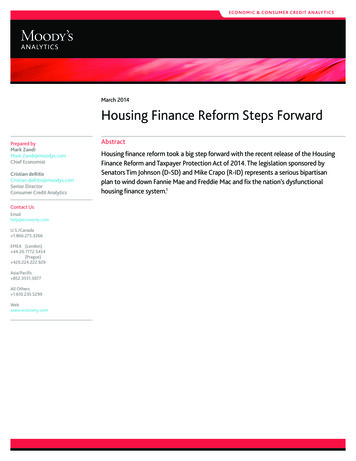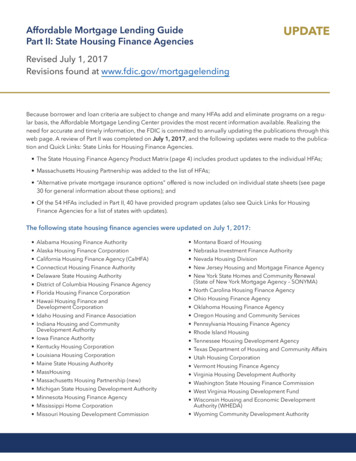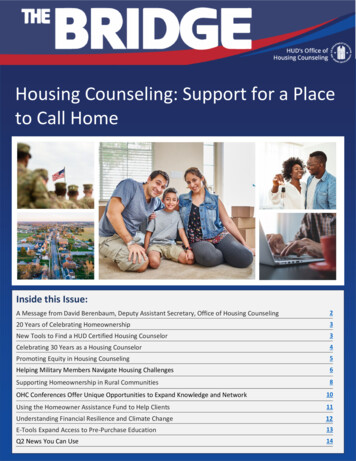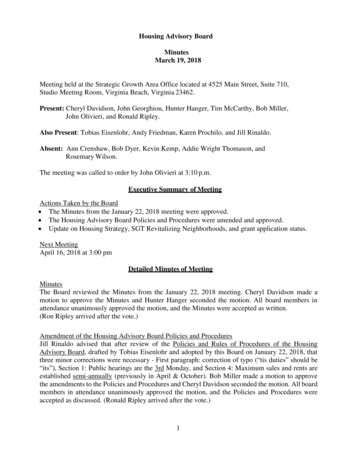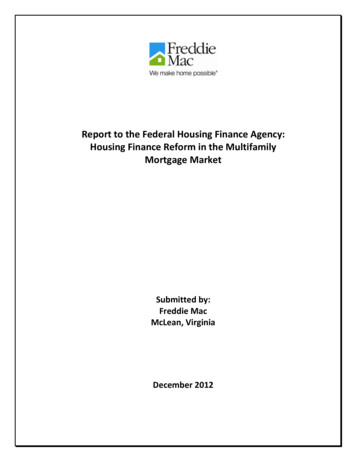
Transcription
Report to the Federal Housing Finance Agency:Housing Finance Reform in the MultifamilyMortgage MarketSubmitted by:Freddie MacMcLean, VirginiaDecember 2012
AbstractTo advance housing finance reform, can the multifamily market attract more private capitaland correspondingly reduce the government’s market footprint and risk exposure to U.S.taxpayers? That is the general question that our regulator and conservator, the FederalHousing Finance Agency (FHFA), asked of Freddie Mac in early 2012. Namely, can FreddieMac’s multifamily business remain viable if it were restructured into a stand-alone entitywithout access to a government guarantee? If so, what would change as a result, both inour business as well as the broader marketplace?This report addresses these questions in depth. Our key findings: 1) without access to agovernment guarantee, our multifamily business could attract private investment andproduce net income; 2) our business would look and operate very differently; 3)withdrawing government support would have a negative impact on the broader multifamilymarket; 4) we are prepared to implement changes to our structure; and 5) structuralchanges could be made in steps and over time, which would allow policymakers to addressadverse market impacts as well as create policymaker optionality for long-term reform ofthe U.S. housing finance system.These findings reflect extensive analysis and original research performed by a crosscorporate working group within Freddie Mac, led by David M. Brickman, senior vicepresident of the multifamily business. For added perspective, we commissioned studies byfinancial advisers, Barclays Capital Inc. and Morgan Stanley, which developed financialforecasts and valuations for a prospective new business entity. We also contracted witheconomic research consultants, CBRE Global Research and Consulting and Moody’sAnalytics, which estimated how the broader multifamily market would be affected byremoving access to a government guarantee, an area where Hartrey Advisers also providedcounsel.This report was reviewed by Donald H. Layton, chief executive officer, Ross J. Kari, chieffinancial officer, and Jerry Weiss, chief administrative officer. Freddie Mac’s board ofdirectors was briefed on the contents of this report.We have structured this report in several sections. An executive summary reviews keyfindings. We describe our current business model and its recent results. We reviewestimates for a financial forecast and market valuation regarding a new business modeloperating without access to a government guarantee. (For comparison purposes, weinclude estimates of a limited government guarantee model.) We estimate impacts of thisnew business model, and a similar change to Fannie Mae’s multifamily business, onmultifamily housing and mortgage markets. We then describe how we could implementstructural change. Lastly, we include appendices that discuss methodologies and elaborateon subject matter. We hope this report advances the process to reform the housing financemarket. And we await further direction from FHFA and policymakers.Freddie Mac Report on:Housing Finance Reform in Multifamily Mortgage MarketDecember 2012Main Report – Page 1
Table of Contents1.2.3.4.5.6.Executive SummaryBackground: The Multifamily Business TodayNew Entity Financial Forecast and ValuationMarket Impact AnalysisOperational AnalysisConclusionPage 3Page 9Page 14Page 24Page 37Page 44Appendix I: New Entity Financial Forecast and Valuationa. No Guarantee Scenario: Detailed Assumptions,Financial Forecasts, Sensitivities, and Valuationb. Portfolio Management Feec. Valuation Approach and Cost of Capitald. Guarantee Feee. Alternative Scenario: Detailed Assumptions,Financial Forecasts, Sensitivities, and ValuationAppendix II: Market Impact Analysisa. Freddie Mac Study: “The Economic Impact on theMultifamily Rental Housing Market of Removingthe Government Guarantee”Appendix III: Operational Analysisa. Asset Isolation Timelineb. Current-State Systems and Application Overviewc. Technology Phase Road Mapd. Operational Separation Road MapFreddie Mac Report on:Housing Finance Reform in Multifamily Mortgage MarketDecember 2012Main Report – Page 2
1. EXECUTIVE SUMMARYIn its strategic plan published in early 2012, the Federal Housing Finance Agency (FHFA)established a framework regarding the future state of Freddie Mac and Fannie Mae.Notably, FHFA articulated the many distinctions between our single-family and multifamilybusinesses, and how those differences might shape their respective futures. FHFA stated:“Generating potential value for taxpayers and contracting the Enterprises’ multifamilymarket footprint should be approached differently from single-family, and it may beaccomplished using a much different and more direct method.”FHFA then followed-up with a conservatorship scorecard objective for us: “Undertake amarket analysis by December 31, 2012, of the viability of multifamily business operationswithout government guarantees. Review the likely viability of these models operating on astand-alone basis after attracting private capital and adjusting pricing if needed.”This document represents Freddie Mac’s response to this scorecard item. Our responseexamines the impact of operating our multifamily business without a governmentguarantee on: 1) the economics and business model of our multifamily business; 2) thebroader multifamily marketplace; and 3) the operational preparedness of our organization.To develop estimates contained in our response, we enlisted several external parties:Barclays Capital Inc., CBRE Global Research and Consulting, Ernst & Young, Hartrey Advisers,Moody’s Analytics, and Morgan Stanley. We conducted original research. We intervieweda wide range of market participants. And we leveraged related internal work that evaluatedpossible future states for Freddie Mac’s multifamily business.Importantly, our analysis identifies impacts to the multifamily market that affect publicpolicy, such as the availability of mortgage funding, value of housing stock, and access toaffordable housing. We do not take a position on these issues; the Obama Administrationand Congress are the rightful places to address these issues.Our Multifamily Business TodaySince one-third of U.S. residents rent rather than own their homes, Freddie Mac has amultifamily business (“Multifamily”). It is a business that is profitable, supports affordablerental housing, and transfers risk, both credit and interest rate, to private capital markets.In some ways, Multifamily looks like our single-family business. For instance, Multifamilyoperates in the secondary mortgage market that supports housing in the United States. Wepurchase loans originated by lenders, package loans into mortgage-backed securities, issueour securities to institutional investors, and provide a counter-cyclical source of mortgageliquidity.Freddie Mac Report on:Housing Finance Reform in Multifamily Mortgage MarketDecember 2012Main Report – Page 3
Compared to single-family, Multifamily has lower loan volumes, a higher-quality portfolioand a smaller market footprint. For instance, while our single-family business holds roughly20 percent of outstanding mortgage debt in that market, Multifamily holds 13 percent in itsmarket. Another difference: Multifamily has a disproportionately larger impact onaffordable housing. In any given year, Multifamily loans can represent roughly five percentof Freddie Mac’s total loan volume, but as much as one-third of our affordable housingunits.But that is where comparisons to single-family end. Multifamily loans finance new orrehabilitated apartment buildings, have an average loan size of 17 million, and are sourcedby a small, closed network of lending institutions. Because every property and deal areunique, we require credit underwriting that involves on-site inspections, analyses of currentand projected operating income statements of properties, and screening of propertyowners and building management. Thus, Multifamily is a form of commercial lending.Since 2010, Multifamily has produced earnings approaching 4 billion. We produce revenueby creating securities based on loans we purchase, as well as realizing net interest incomeon loans and securities we hold in portfolio. Our value is driven, in part, by economies ofscale (compared to other multifamily financiers) and access to a government guarantee.Our size enables us to issue large volumes of mortgage-related securities on a regular andpredictable schedule, a feature embraced by capital markets. And the guarantee ensuresour continuous market presence, another feature valuable to investors, lenders andborrowers.Another driver of securities value: credit risk management. We strive to adhere to aconservative risk management position in all business cycles. Currently, Multifamily hasvery low loan delinquency rates (24 basis points, as of October 2012) and credit losses (lessthan one basis point relative to the size of our portfolio, year to date).As a government-sponsored enterprise (GSE), our business operates in all business cycles.In many ways, Multifamily operates like an accordion, expanding when private capitalsources are diminished and contracting when private capital is abundant. For instance,when the financial crisis began in 2008, many private sources of multifamily funding exitedthe market. In response, our business expanded its operational capacity and roughlydoubled its market share. As private capital reentered the market, our market sharedeclined.Freddie Mac Report on:Housing Finance Reform in Multifamily Mortgage MarketDecember 2012Main Report – Page 4
Is It Viable to Operate the Multifamily Business without A Government Guarantee?Economically, YesAbsent access to a government guarantee, our business would look and operate differentlythan it does today. Multifamily would no longer be a line of business within Freddie Mac.Instead, it likely would be a private, monoline financial firm, operating on a stand-alonebasis, attracting private capital from equity and debt investors, and complying with allapplicable regulations in areas such as capital levels and taxation. As such, our investmentadvisers believe that a stand-alone Multifamily would have a market valuation similar tothat of other large multifamily conduits or lenders. Here, we would rely on our operatingplatform, capital markets expertise, risk-management approach, staff knowledge, and longstanding stakeholder relationships.Multifamily would operate more like a true conduit – i.e., purchasing and securitizing loans - have a smaller market footprint, charge higher mortgage interest rates, and produce netincome, although less than today. The business would experience less favorable pricing onsecurities, higher cost of funds on corporate borrowings, and a smaller market presence.Capitalizing monoline financial firms can be difficult; investors view the lack ofdiversification to pose more risk. Thus, to minimize the initial capitalization needs of astand-alone entity, Multifamily likely would propose to treat its existing loan and securitiesportfolio -- which is still very profitable but capital intensive to operate – as legacy and leaveit with Freddie Mac, perhaps with an agreement to service the portfolio for a fee.Multifamily would be free to integrate vertically within the multifamily market andhorizontally within commercial real estate, should profitable opportunities arise. At thesame time, the business likely would withdraw from unprofitable niches such as affordablehousing for some lower-income renters -- to date, access to a government guarantee hasmade that segment a relatively break-even business for us – and otherwise contractoperations to fit a lower-volume business.Further, our investor base would be smaller and different than today. With lower volumesand fewer issuances, our securities would be less liquid and less attractive to investors.And, rather than maintaining a constant market presence, we would be incented to behavelike other private entities, entering and exiting markets as profitable opportunities dictate.The business would be rebranded and marketed as a new entity distinct from Freddie Mac.In the following chart, we provide a 10-year range (2013-2022) of estimated financialmeasures for a stand-alone business, determined by Freddie Mac and our investmentadvisers, which operates without access to a government guarantee and sheds much of itsexisting loan portfolio. For comparison purposes, we have modeled a similar stand-aloneentity that has access to a limited government guarantee for our senior securities only, paysa guarantee fee to its provider, but otherwise enjoys no other privileges commonlyFreddie Mac Report on:Housing Finance Reform in Multifamily Mortgage MarketDecember 2012Main Report – Page 5
associated with GSEs (e.g., implied government guarantee on debt, exemption from stateand local income taxes, etc.).Key MetricEntity net valuationNet income, annualPurchase volume, annualMarket share, annualInitial equity investmentCost of debt:Repurchase agreementsWarehouse lines of creditCost of equityMarket capitalRegulatory capitalStand-Alone Multifamilywithout Access toGovernment Guarantee 100-500 million 100-150 million 6-18 billion5-14 percent 500-600 millionStand-Alone Multifamilywith Access to a LimitedGovernment Guarantee 1.7-3.2 billion 350-775 million 24-31 billion16-19 percent 1.4-2.8 billionLIBOR 50 bpsLIBOR 200-250 bps9-17 percent 380-730 million 100-160 millionLIBOR 50 bpsLIBOR 125-225 bps7-14 percent 1.4-8.2 billion 0.7- 4.7 billionNote – Key financial information provided by our financial advisers and incorporated into their earningsprojections. Our financial advisers used projected earnings in years 1 and 3 to derive their respective entity netvaluation ranges.Would Withdrawing A Government Guarantee Affect the Broader Marketplace?YesMuch like how our business would look very different without access to a governmentguarantee, the broader marketplace also would be affected.For instance, there likely would be a funding gap where demand for multifamily rentalfinancing exceeds available sources. A no-guarantee business model likely would result in areduction in annual purchase volumes purchased by successor entities to Freddie Mac andFannie Mae’s multifamily businesses. Freddie Mac and our economic research consultantsestimate that, once converted into private entities without access to a governmentguarantee, post-GSE multifamily businesses would purchase 39 billion less in loansannually in the near term, compared to current activity. The resulting gap would have to beabsorbed by other market participants.Freddie Mac and our economic research consultants estimate that conduits, banks and lifeinsurers likely would fill 18-29 billion of this gap, leaving a net funding gap of 10-21 billionannually in the near term. Conduit market share through the commercial mortgage-backedsecurities would increase, but growth would be affected by investor confidence in CMBS,regulatory uncertainties and operational considerations. Portfolio lenders would return tohistorical levels, but Basel III capital rules likely would limit further growth. Life insurerswould increase their market share as well, but they would be unlikely to venture outsideFreddie Mac Report on:Housing Finance Reform in Multifamily Mortgage MarketDecember 2012Main Report – Page 6
their niche of the highest-quality loans and Cadillac-style properties known as Class A, whichare newer and larger, charge higher rents, and are typically located in large urban centersalong the east and west coasts.Moreover, funding demand likely would increase over time, as demographic changes andconsumer preference for rental housing pressure the multifamily market to expand. Withless debt funding available, mortgage interest rates and rents likely would increase, andproperty values and housing supply would decline.Affordable housing would be another impacted area. In analyzing Freddie Mac’s currentloan purchases, the vast majority of Multifamily loans support lower-income householdsresiding in Class B properties, which are generally older and smaller properties, with moreaffordable rents and located in less-populated markets throughout the country. To theextent that other market participants expand their businesses to partially offset a fundinggap, Freddie Mac and our economic research consultants believe that much of this volumewould focus on higher-income households in Class A properties along the coasts.Lastly, withdrawing a government guarantee would affect the ability of the multifamilymarket to sustain boom-and-bust cycles. In short, the market would not have access to acounter-cyclical source of funding as it does today (i.e., the GSEs) and, as a result, operatemuch like other forms of commercial real estate. In this scenario, we expect that boomand-bust cycles would become more frequent and severe.The following chart summarizes key findings.Key Market MetricDirection of ImpactMortgage debt availabilityMortgage interest ratesProperty valuesCapitalization ratesReal rentRental housing supply reaseNo-Guarantee Impacton Multifamily Market- 10-20 percent 50-150 bps- 4-16 percent 30-120 bps 0.2-2.1 percent- 4-27 percentCan Multifamily Transition into A Stand-Alone Structure?YesShould policymakers change our operating structure, we have developed a work plan toimplement a transition. The volume of transition work would not be insignificant. In brief,we would have to arrange for new structures for corporate governance, capitalmanagement, regulatory compliance, financial reporting, human resources, and businessoperations. We would have to do this knowing that benefits of a GSE would end as privateequity takes ownership.Freddie Mac Report on:Housing Finance Reform in Multifamily Mortgage MarketDecember 2012Main Report – Page 7
We estimate that it would take roughly 24 months to fully complete a transition to a standalone entity outside of Freddie Mac. The FHFA would have to determine whether and atwhat stage legislative approval is necessary. For our part, certain factors could make anytransition somewhat easier to implement.First, Multifamily is relatively distinct within Freddie Mac today. For instance, the businesshas dedicated support for capital markets, portfolio management, production and sales,underwriting, asset management, business operations and, indirectly, finance, credit riskmanagement, technology, legal, human resources, and communications. Roughly 400employees work in the multifamily division and 100 in other areas within the line ofbusiness.Second, Multifamily already has performed extensive research on the practical issuesinvolved in creating an alternate operating structure. We have reviewed the potentialeffects on our legal structure, taxation, governance, parent relationship, financial reportingand related systems, internal controls, human resources, and more.Should FHFA direct a restructuring of Multifamily, industry best practices suggest a phasedapproach. For instance, initial work could establish Multifamily as a stand-alone entitywithin Freddie Mac. This would allow Freddie Mac to determine the core parts of operatinginfrastructure that the business requires. From there, FHFA and policymakers could chooseto move Multifamily outside of Freddie Mac and seek to raise private equity, or leaveMultifamily within Freddie Mac and/or its successor. Policymaker decisions on access to agovernment guarantee could be made at different phases of restructuring.SummaryAs you will read, Freddie Mac, investment advisers and economic research consultants haveperformed research on whether and how our multifamily business might be able to operateon a stand-alone basis. Absent access to a government guarantee, the business would beeconomically viable. But it would operate and interact with the market differently thantoday. We attempt to paint a clear picture for what that business might look like. And weattempt to quantify how removing government guarantees would affect the broadermarket.We also have performed some of the legwork to prepare our business for change. We havedeveloped operational designs that are flexible enough to work in various outcomes, insideand outside Freddie Mac, with and without access to a government guarantee. And we lookforward to continue working with FHFA and policymakers to help shape the future of thehousing finance market for rental housing.Freddie Mac Report on:Housing Finance Reform in Multifamily Mortgage MarketDecember 2012Main Report – Page 8
2. BACKGROUND: THE MULTIFAMILY BUSINESS TODAYFreddie Mac’s multifamily business operates in the secondary market for multifamilyhousing finance within the United States. Multifamily today is a profitable business thatrelies, in part, on securitization, credit risk management, a loan sourcing network, andemployee expertise. The vast majority of Multifamily’s loan purchases support rentalhousing for lower-income households. And the business operates as a counter-cyclicalsource of mortgage financing.To provide context for evaluating a change in Multifamily’s structure, let’s briefly review thedistinguishing features of our business, along with recent results.Securitization. One main feature of our business model is securitization. Here, we offer abranded version of structured pass-through certificates, known as K-deals, to capital marketinvestors. These securities are based on loans that are sourced from our network of lendersand directly underwritten by Freddie Mac staff. Loan quality, the size of annual purchasevolumes, and investor interest affect Multifamily’s ability to issue certificates on a regular,predictable schedule. We typically conduct K-deals monthly through a securities offeringthat is backed by roughly 1 billion in multifamily loans recently purchased by Freddie Mac.Currently, our business is the largest issuer of multifamily structured debt in the U.S. capitalmarkets.Our securities are structured in a way in which private investors, not U.S. taxpayers, bearmost of the losses that might come in any one security. We do this by including a nonguaranteed portion, a subordinate bond, which assumes a first-loss position borne byprivate investors. The remaining portion, a senior tranche rated AAA, is guaranteed byFreddie Mac. To date, our K-deal securities have not experienced any losses.Credit Risk Management. Multifamily underwriting is different than that for single-family.Every apartment building is unique and the typical size of a Multifamily loan is 17 million.Because of these and other differences, Multifamily directly underwrites every loan that wefinance. We do so on a prior-approval basis, meaning that lenders cannot commit loanterms to a borrower until Freddie Mac has completed its underwriting process. For ourevaluation of its risk-based terms, we rely on an in-house staff of underwriters, attorneysand capital market staff.We also rely on credit policies that we communicate to lenders and borrowers. We strive tomake these policies conservative in their risk position and sustainable across varyingeconomic environments. We also rely on asset management staff to ensure appropriateand consistent loan servicing. Our loan portfolio currently has very low loan delinquencyrates (24 basis points, as of October 2012) and credit losses (less than one basis point of ourloan portfolio, year-to-date).Freddie Mac Report on:Housing Finance Reform in Multifamily Mortgage MarketDecember 2012Main Report – Page 9
We apply the same credit underwriting and servicing standards to loans whether we investin them directly through our investment portfolio or securitize them through K-deals. Thisconsistency and loan quality enables us to attract a high demand for our securities, which inturn allows us to provide a reliable flow of liquidity to our lenders and borrowers.Loan Sourcing. Because multifamily financing is a specialty, we purchase loans only from asmall network of lenders. These lenders, known as Program Plus lenders, havedemonstrated experience in multifamily lending, knowledge of local market conditions, andclose relationships with borrowers. Our lenders also may service loans if they so choose.We work together with our lenders to allocate specific geographic regions in which they canspecialize and source loans eligible for sale to Freddie Mac. The majority of our loanpurchases come from repeat borrowers.To serve lower-income renters and other underserved segments, we also have a similarnetwork of lenders in our Targeted Affordable Housing program. Here, these lendersspecialize in financing apartments where a majority of units are reserved for renters withlow and very low incomes. Together, we structure deals that involve available governmentincentives as well as our own direct financing.Employees and Operations. Because our business model is relationship-oriented, we relyon staff with extensive knowledge of the multifamily marketplace. These staff analyzemarkets, develop credit policies that balance the needs of maintaining a competitiveposition in the market while protecting the Multifamily franchise, work with our lenders andborrowers to identify and underwrite appropriate deals, and structure securities that meetinvestor needs.Multifamily also has a significant number of information systems that support the business.These systems are designed to enable Multifamily to process large volumes of transactions,simplify the customer experience, comply with corporate policies and practices, andimprove loan quality. Today, roughly 500 employees work in the Multifamily line ofbusiness, with 400 currently working in the Multifamily division and another 100 in otherdivisions that support the line of business.Freddie Mac Report on:Housing Finance Reform in Multifamily Mortgage MarketDecember 2012Main Report – Page 10
Recent ResultsNet Income. At 1.65 billion, Multifamily earnings accelerated during the first threequarters of 2012, already eclipsing full-year 2011. Since 2010, Freddie Mac’s multifamilybusiness has produced almost 4 billion in net income for taxpayers.Affordable Housing. During the first three quarters of 2012, Multifamily financed 303,000apartment units. The vast majority of our loans supported affordable housing for people ator below the local area median income. Since 2010, Freddie Mac’s multifamily business hasfinanced 858,000 apartment units.Freddie Mac Report on:Housing Finance Reform in Multifamily Mortgage MarketDecember 2012Main Report – Page 11
Loan Sourcing. At 19.2 billion, Multifamily loan purchases in the first three quarters of2012 enabled borrowers to finance new loans for apartment buildings and refinanceexisting loans at lower rates. Since 2010, Freddie Mac’s multifamily business has funded 54.9 billion in loans. We estimate that our share of total multifamily mortgage debtoutstanding is 13 percent.Securitization. During the first three quarters of 2012, Multifamily settled 13.9 billion inFreddie Mac multifamily securities, known as K-deals. Since 2010, we have settled 29 Kdeals totaling 34 billion. Our securities transfer risk to private investors.Freddie Mac Report on:Housing Finance Reform in Multifamily Mortgage MarketDecember 2012Main Report – Page 12
Credit Risk Management. As of September 2012, Multifamily’s loan delinquency rate was27 basis points. In contrast, the delinquency rate on multifamily commercial mortgagebacked securities was 965 bps – or 35 times worse. On a loan portfolio of 126 billion,Freddie Mac’s multifamily credit losses during first three quarters of 2012 were 6 million, aloss rate of less than one basis point.Freddie Mac Report on:Housing Finance Reform in Multifamily Mortgage MarketDecember 2012Main Report – Page 13
3. NEW ENTITY FINANCIAL FORECAST AND VALUATIONOperating Freddie Mac’s multifamily business as a stand-alone entity without access to agovernment guarantee is an economically viable option. The new entity would have amarket valuation similar to that of large conduits and lenders, up to 500 million. Thebusiness would look and function differently than today and operate without all theprivileges of a GSE (e.g. implied government guarantee of debt, exemption from state andlocal income taxes, etc.).Presumably no longer in conservatorship, the entity would be in a position to expand itsproducts and services into areas previously untapped or constrained. It would be free toexit unprofitable businesses. And the existing people, processes and infrastructure wouldenable the business to occupy a niche in the marketplace. But the entity would lose theadvantages of favorable pricing on securities and a low cost of funds on corporateborrowings, which are the key advantages of a government guarantee. Further, the entitywould not have the scale and deep investor base that it currently enjoys.To assist in assessing the proposed new entity’s viability, Freddie Mac retained two financialadvisory firms, Barclays Capital Inc. and Morgan Stanley, to provide analysis and guidanceregarding the structure, profitability and valuation of such an entity. Projections reflect thegeneral assumption that the new entity would be independent of Freddie Mac on a proforma basis, effective January 1, 2013.This section examines various aspects of the proposed new entity, such as business model,potential opportunities, capital and funding, projected financial results, and valuation. Forcomparison purposes, Freddie Mac and its financial advisers also analyzed a scenario inwhich the entity would have access to a limited guarantee. Additional information thatdiscusses financial methodologies and assumptions is contained in Appendix I.New Business ModelWhat would our multifamily business look like without access to a government guarantee?Fre
our securities to institutional investors, and provide a counter-cyclical source of mortgage liquidity. Freddie Mac Report on: Main Report - Page 4 Housing Finance Reform in Multifamily Mortgage Market December 2012 Compared to single-family, Multifamily has lower loan volumes, a higher-quality portfolio



